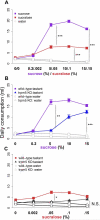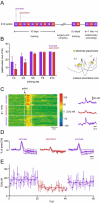Taste uncoupled from nutrition fails to sustain the reinforcing properties of food
- PMID: 22712685
- PMCID: PMC3424366
- DOI: 10.1111/j.1460-9568.2012.08167.x
Taste uncoupled from nutrition fails to sustain the reinforcing properties of food
Abstract
Recent findings suggest the reward system encodes metabolic value independent of taste, provoking speculation that the hedonic value of taste could be derived from nutritional value as a secondary appetitive property. We therefore dissociated and compared the impact of nutrition and taste on appetitive behavior in several paradigms. Though taste alone induces preference and increased consumption, in the absence of nutritional value its reinforcing properties are greatly diminished and it does not, like sucrose, induce increased responding over time. In agreement with behavioral data, saccharin-evoked (but not sucrose-evoked) dopamine release is greatly attenuated following pre-exposure, suggesting that nutritional value is critical for dopamine-mediated reward and reinforcement. Further supporting the primacy of nutrition over taste, genetically increased dopaminergic tone enhances incentive associated with nutritional value with minimal impact on taste-based, hedonic incentive. Overall, we suggest that the sensory-hedonic incentive value associated with taste functions as a conditioned stimulus that requires nutritional value to sustainably organize appetitive behavior.
© 2012 The Authors. European Journal of Neuroscience © 2012 Federation of European Neuroscience Societies and Blackwell Publishing Ltd.
Figures







References
-
- Badia-Elder N, Kiefer SW, Dess NK. Taste reactivity in rats selectively bred for high vs. low saccharin consumption. Physiol Behav. 1996;59:749–755. - PubMed
-
- Balleine BW. Neural bases of food-seeking: affect, arousal and reward in corticostriatolimbic circuits. Physiol Behav. Physiol Behav. 2005;86:717–730. - PubMed
-
- Bassareo V, Di Chiara G. Differential responsiveness of dopamine transmission to food-stimuli in nucleus accumbens shell/core compartments. Neuroscience. 1999;89:637–641. - PubMed
Publication types
MeSH terms
Substances
Grants and funding
LinkOut - more resources
Full Text Sources
Other Literature Sources

